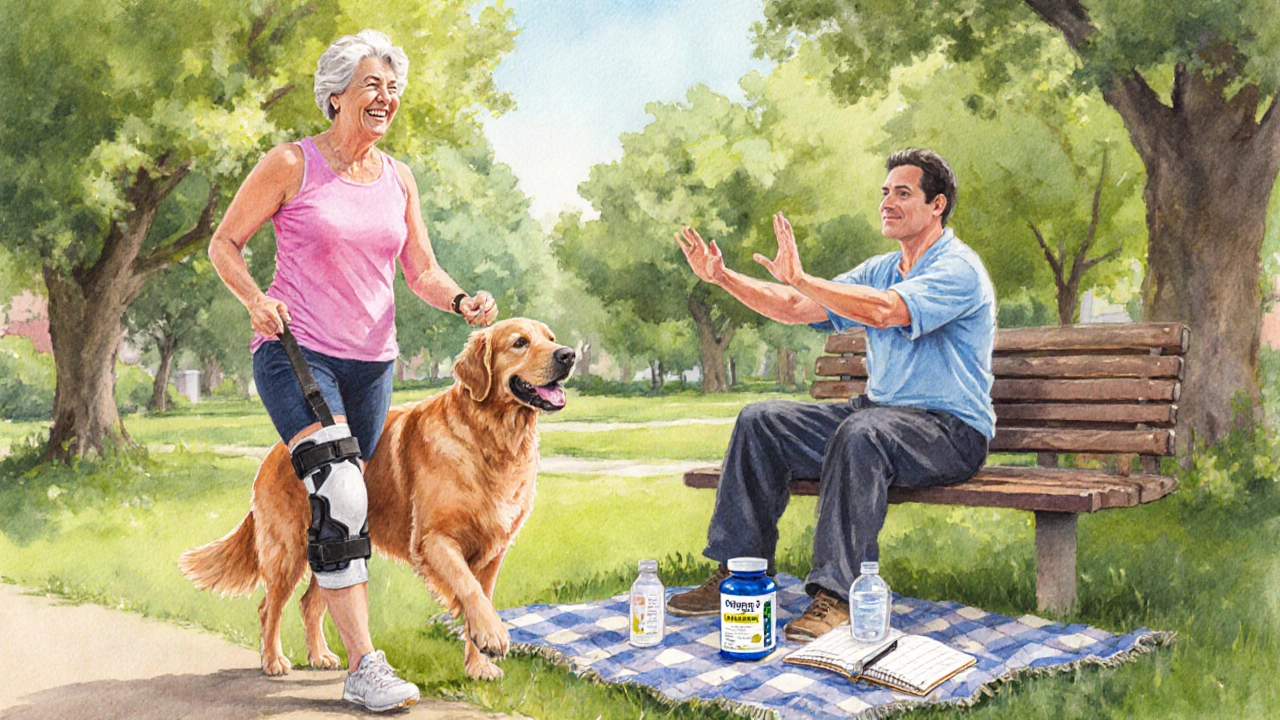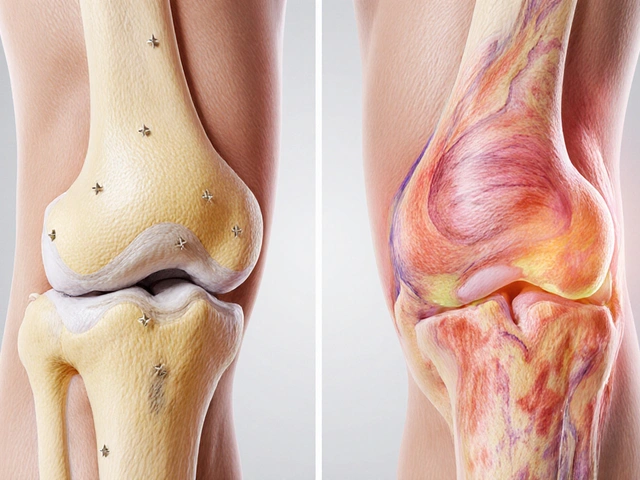Osteoarthritis vs Rheumatoid Arthritis Quiz
1. What is the primary cause of osteoarthritis?
2. Which symptom is more typical of rheumatoid arthritis?
3. What type of inflammation is characteristic of rheumatoid arthritis?
4. At what age does osteoarthritis typically begin?
When people hear the word “arthritis,” they often picture creaky knees or swollen wrists and assume it’s all the same thing. In reality, osteoarthritis is a degenerative joint disease that wears down cartilage over time, while Rheumatoid arthritis is an autoimmune disorder that attacks the joint lining. Understanding how these two conditions overlap-and where they diverge-helps patients, caregivers, and clinicians make smarter choices about diagnosis, treatment, and lifestyle.
Quick Take
- OA is wear‑and‑tear; RA is immune‑driven inflammation.
- Both can cause joint pain, stiffness, and reduced mobility.
- Shared risk factors include age, obesity, and joint injury.
- Early detection of RA prevents irreversible joint damage.
- Management often combines medication, physical therapy, and lifestyle tweaks.
What Exactly Is Osteoarthritis?
Osteoarthritis (OA) develops when the smooth cartilage that cushions the ends of bones starts to break down. Cartilage is a flexible, connective tissue that reduces friction in synovial joints loses its moisture and elasticity, leading to bone‑on‑bone contact, pain, and sometimes bone spurs. The most common sites are knees, hips, hands, and the spine.
Key triggers include:
- Age: cartilage regeneration slows after 45.
- Obesity: extra weight adds mechanical stress, especially on the knees.
- Joint injury: a past fracture or ligament tear can kick‑start cartilage wear.
- Genetics: certain families inherit a higher susceptibility.
What Exactly Is Rheumatoid Arthritis?
Rheumatoid arthritis (RA) is a systemic Autoimmune disease where the immune system mistakenly attacks the body’s own tissues. In RA, the immune attack focuses on the synovial membrane-the thin lining inside Synovial joint a joint that contains fluid for smooth movement. The inflamed synovium thickens, releases destructive enzymes, and eventually erodes cartilage and bone.
Typical early signs:
- Symmetrical joint swelling (both hands, both knees, etc.).
- Morning stiffness lasting more than an hour.
- Systemic symptoms like fatigue, low‑grade fever, and weight loss.
Where Do They Overlap?
Even though OA and RA arise from different biological pathways, they share several clinical features that can blur the diagnostic line:
- Joint pain is the primary symptom in both conditions, often worsening with activity.
- Both can lead to reduced range of motion and functional limitations.
- Obesity is a common modifiable risk factor, increasing mechanical load for OA and inflammatory markers for RA.
- Age‑related immune changes (immunosenescence) may predispose older adults to a milder, OA‑like presentation of RA.
Because of these overlaps, clinicians rely on blood tests (RF, anti‑CCP antibodies), imaging, and detailed history to differentiate them.

Key Differences at a Glance
| Feature | Osteoarthritis (OA) | Rheumatoid Arthritis (RA) |
|---|---|---|
| Root cause | Degenerative wear of cartilage | Autoimmune inflammation of synovium |
| Typical onset age | 45+ years | 20‑50 years (can appear later) |
| Joint pattern | Often isolated (e.g., one knee) | Symmetrical, multiple joints |
| Morning stiffness | Usually < 30 minutes | > 60 minutes |
| Inflammatory markers | Normal ESR/CRP | Elevated ESR/CRP, positive RF/anti‑CCP |
| Radiographic signs | Joint space narrowing, osteophytes | Joint erosions, soft‑tissue swelling |
| Treatment focus | Pain control, joint preservation | Immune suppression, disease modification |
Why the Confusion Matters
If a patient with early RA is mislabeled as having OA, they may miss out on disease‑modifying antirheumatic drugs (DMARDs) that can halt joint erosion. Conversely, treating OA as if it were RA could expose someone to unnecessary immunosuppressants, raising infection risk.
Accurate differentiation guides three critical decisions:
- Medication choice: NSAIDs are common to both, but only RA benefits from biologics like etanercept.
- Rehabilitation strategy: OA responders often thrive on low‑impact aerobic exercise, whereas RA patients may need joint‑protective splints during flare‑ups.
- Long‑term monitoring: RA requires regular imaging to track erosions, while OA monitoring focuses on functional scores and pain levels.
Shared Management Strategies
Despite their differences, many lifestyle tactics help both conditions:
- Physical therapy optimizes muscle strength and joint stability improves gait, reduces load, and eases pain.
- Weight management lessens mechanical stress for OA and lowers pro‑inflammatory cytokines in RA.
- Joint‑friendly activities-swimming, cycling, tai chi-maintain range of motion without over‑loading joints.
- Omega‑3 rich diets (e.g., fatty fish) show modest anti‑inflammatory effects useful for both.
When medication is needed, the approach diverges:
- OA: acetaminophen, topical NSAIDs, intra‑articular corticosteroid injections, hyaluronic acid fillers.
- RA: conventional DMARDs (methotrexate), biologic agents (TNF inhibitors), short‑course glucocorticoids for flare control.
Red Flags: When to Seek Specialist Care
Any of the following warrants prompt rheumatology referral:
- Sudden, severe joint swelling in multiple sites.
- Morning stiffness lasting longer than an hour.
- Unexplained fatigue, fever, or loss of appetite.
- Rapidly progressive pain that interferes with daily tasks.
Early intervention, particularly for RA, can preserve joint function for decades.
Frequently Asked Questions
Can someone have both osteoarthritis and rheumatoid arthritis?
Yes. It’s not uncommon for an older adult with established OA to later develop RA, especially if there’s a family history of autoimmune disease. Management then targets both wear‑and‑tear symptoms and immune‑mediated inflammation.
Are blood tests reliable for distinguishing OA from RA?
Blood tests help but aren’t definitive. Rheumatoid factor (RF) and anti‑CCP antibodies are positive in many RA cases, while they’re usually absent in pure OA. However, seronegative RA exists, so clinicians also weigh imaging and clinical patterns.
Does diet influence osteoarthritis progression?
Emerging research links high‑sugar, processed‑food diets to increased inflammation, which can exacerbate OA pain. A Mediterranean‑style diet rich in fruits, vegetables, whole grains, and olive oil may modestly slow symptom progression.
When are joint injections appropriate?
In OA, corticosteroid or hyaluronic acid injections can provide short‑term relief for heavily affected joints like the knee. In RA, injections are used during localized flares but are usually combined with systemic DMARD therapy.
What role does genetics play?
Genetics contributes to both. Specific HLA‑DRB1 alleles raise RA risk, while variants in the COL2A1 gene and others influence cartilage integrity, making some people more prone to OA.

Bottom Line
Osteoarthritis and rheumatoid arthritis share symptoms but stem from distinct mechanisms-wear‑and‑tear versus autoimmune inflammation. Recognizing their differences ensures the right meds, the right rehab, and the right timing for specialist care. By tackling common risk factors like weight and inactivity, and by staying alert to red‑flag symptoms, patients can keep joints healthier for longer, whether they’re battling OA, RA, or both.


Maureen Crandall
September 30, 2025 AT 18:33Listen people weight matters more than you think for arthritic pain it’s not just old age it’s the extra load on joints that speeds cartilage wear stop ignoring the scale
Michelle Pellin
September 30, 2025 AT 20:46My dear readers, the distinction between osteoarthritis and rheumatoid arthritis is nothing short of a tragic tale of two adversaries locked in a relentless duel; one, a slow‑burning erosion of cartilage, the other, a fiery onslaught of immune aggression that spares neither morning nor night, and yet both conspire to shatter the very choreography of our movements.
Keiber Marquez
September 30, 2025 AT 23:00Look folks, this article misses the point the real problem is we ain’t doing enough to protect our nation’s health we need stronger medics and better tech not just talk about diet
Lily Saeli
October 1, 2025 AT 01:13One might argue that the body is a microcosm of society, each joint a silent contract broken when we betray our own physical covenant; thus neglecting joint health becomes a moral failing as much as a medical one.
Joshua Brown
October 1, 2025 AT 03:26Indeed, when addressing osteoarthritis versus rheumatoid arthritis, clinicians should first assess patient history, then evaluate laboratory markers, subsequently order imaging studies, and finally tailor a multidisciplinary treatment plan that incorporates pharmacotherapy, physical therapy, and lifestyle modifications.
andrew bigdick
October 1, 2025 AT 05:40It’s worth noting that regular low‑impact exercise like swimming can ease OA symptoms while also boosting overall immune function, which may indirectly help manage RA flare‑ups.
Shelby Wright
October 1, 2025 AT 07:53Honestly, the whole “different diseases” narrative is overrated; both OA and RA are just two sides of the same painful coin, and the medical community loves to split them for fancy research grants.
Ellen Laird
October 1, 2025 AT 10:06While the literature glorifies rheumatoid arthiritis as a noble autoimmune crusade, the plain truth lies in the mundane wear of osteoarthritic cartilage-both deserve equal scholarly attention.
rafaat pronoy
October 1, 2025 AT 12:20Cool article, learned a lot 😊 especially about how weight loss can calm both conditions.
Matt Miller
October 1, 2025 AT 14:33Weight management is key.
Fabio Max
October 1, 2025 AT 16:46Great summary! Remember that small daily habits-like a short walk after dinner or a quick stretch-can accumulate into big improvements over months. Keep sharing these insights; they empower many.
Darrell Wardsteele
October 1, 2025 AT 19:00While the article is informative, it suffers from numerous grammatical oversights; for instance, “autoimmune disorder that attacks the joint lining” should be punctuated with a comma after “disorder”. Moreover, the repeated use of “and” at the start of sentences detracts from professionalism.
Heather Wilkinson
October 1, 2025 AT 21:13Love how you highlighted joint‑friendly activities! 🏊♀️🚴♂️ Keep it up, the community thrives on such positive vibes.
Christopher Pichler
October 1, 2025 AT 23:26From a rheumatologic standpoint, the differential diagnosis hinges on serologic markers-RF, anti‑CCP-and imaging hallmarks such as erosions versus osteophytes; obviously, a layperson could just “feel” the difference, but we prefer evidence‑based precision.
VARUN ELATTUVALAPPIL
October 2, 2025 AT 01:40Now, let’s consider the lifestyle components-diet, exercise, stress management-each of which plays a pivotal role; however, many patients overlook these simple interventions, opting instead for quick pharmaceutical fixes, which, frankly, is a short‑sighted approach.
Kris cree9
October 2, 2025 AT 03:53People should stop ignoring the obvious truth that caring for your joints is a moral duty; if you’re lazy about exercise, you’re basically cheating your body.
Paula Hines
October 2, 2025 AT 06:06We must confront the reality that arthritis is not just a personal ailment but a societal burden. The wear of cartilage in osteoarthritis mirrors the erosion of values in a decaying nation. Rheumatoid arthritis with its immune fury reflects the internal conflicts that plague any community. Both conditions demand vigilance from the individual and the collective. Ignoring them is akin to ignoring a leaking roof on a house of democracy. Prevention starts with weight control and movement. Exercise is the most democratic prescription because it requires no borders. Diet rich in omega‑3s offers a universal benefit. Early diagnosis saves resources that would otherwise fund advanced therapies. Blood tests are tools, not miracles, and must be interpreted wisely. Imaging provides visual evidence that can guide treatment plans. Medications should be tailored, not mass‑prescribed, to avoid unnecessary side effects. Physical therapy restores function and empowers patients. Education spreads awareness and reduces stigma. Ultimately, a nation that protects its joints protects its future.